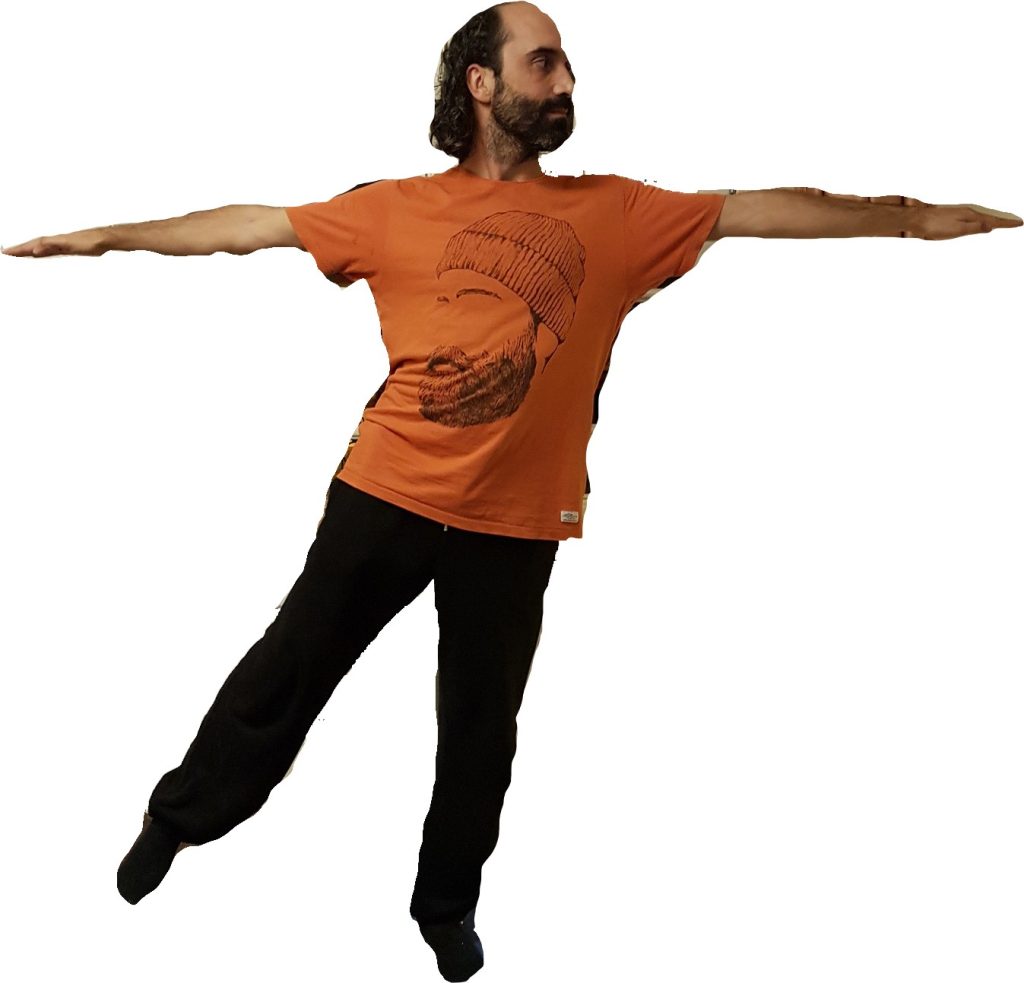Primary Objective of the Ásana
The main goal is to improve balance, both physical and mental, while strengthening the core muscles, as well as hip and shoulder muscles. Garudásana helps to align shoulders and chest. It also opens and balances the heart center. May help with weight management.
Repetitions (standard): 4 rounds (or 4 times on each side)
Length of Posture Holding (ideal): 30 seconds
Breath: Continuous, no kumbhaka.

| Steps of practice | Further details & rationale |
| 1.- Stand erect, turning the body to the right side of the mat..- Raise the left arm forward and the right arm backwards.-Both palms are facing to the right with the arms straight, at shoulder level, and parallel to the ground. – Adjust your center of gravity, so that your weight is supported mostly by the left foot.- The right foot is behind you with the big toe in the ground. – Turn the head facing the direction of the left hand and fix the gaze at a steady point in the horizon. | – The shoulders are relaxed and slightly rolled down the back and the heart center is open.- Rotate the trunk and hips so that hip and shoulder lines are aligned with arms.- The left foot can be pointing in the direction of the left hand or slightly tilted to one of the sides according to one’s particular anatomy or balance needs. – To avoid hyperextension of the knee in this posture,slightly microbend the knee and engage the thigh muscles. Do not lock the knee. -Fixing the gaze on a point will assist in the maintenance of balance.-The entire trunk is rotated slightly to the right. |
| 2.- Lift the back foot a few centimeters off the floor while slightly bending the knee. – If you feel stable enough and want to go further into the posture, raise the right foot a little more as you externally rotate your right hip. – The posture will resemble that of a flying bird. -Breathe normally. -Hold the posture for 30 seconds, but not the breath. | – Do not lean the body forwards as you raise the right leg. Remain erect. – The chest is open. The back is straight. – Only rotate the right hip if it feels comfortable for the rest of the body. – The gaze is directed forwards over the front wingtip hand. |
| 3.-After 30 seconds exit the pose by bringing the feet together, rotating the body back to center, lowering the arms to the sides. Repeat on the other leg. This completes one round. -Practice 4 rounds. -After the last repetition (and in between as needed), stand in Tadásana for a few breaths to integrate the effects of the ásana and let the body return to baseline. One can do some shoulder and hip rotations in the pauses in order to relieve tension. | |
Preparatory Steps
- Shoulder, hip, knee, and ankle rotations.
- To lengthen calves, hamstrings, and adductors: Sahaja Utkatásana/Simple chair.
- Hip extension exercises: Utkata Vajrásana/Difficult thunder.
- To warm up the entire body: Padahastásana/Arm and leg pose, Karmásana/Action pose, Surya Namaskar/Sun salutations, Bhújaungásana/Cobra.
Considerations
Common misalignments
- Bending or leaning the upper body forwards. (The spine needs to be straight and vertical to the floor.
- Arms are dropping or rising and not parallel to the floor.
- Shoulder line is not aligned with the arms – the arms and shoulder line need to form a straight line.
- Shoulders are in tension, lifting up too high – they should be relaxed and slightly rolled backwards.
- The lifted leg is rotated in a way that is out of alignment – the lifted foot should be aligned with the hand on the back; and if the lifted leg is slightly bent, the knee can be slightly out of the plane where the rest of the body is aligned.
Safety essentials
- The knee of the standing leg is not locked, but has a slight microbend.
Modifications
- In the beginning, the face might be facing a little out of line to facilitate balance.
- If you struggle with balance, use the help of a wall.
Variations
- Hands may face down, sideways, or up.
- Holding the forearm of the teacher or another student.
Benefits
- Good for controlling weight, both for reduction and gaining as needed.
- Strengthens shoulders, arms, legs and ankles, as well as pelvic area.
- Improves balance and increases control of the body.
- Tones abdominals organs.
- Increases focus and determination.
- Decreases fear of losing the balance.
- Cultivates patience, concentration and endurance.
Visualizations
- I am flying like a bird, free from worldly entanglements.
- Rain is falling from my wings, drenching the world with feelings of devotion for each other and the Supreme Entity.
- I fly to freedom on the strength of my Inner Being.
Additional Notes: Dada Vijayananda shares that Anandamurti said the ideation should be “flying in the air like a bird, light and happy”.